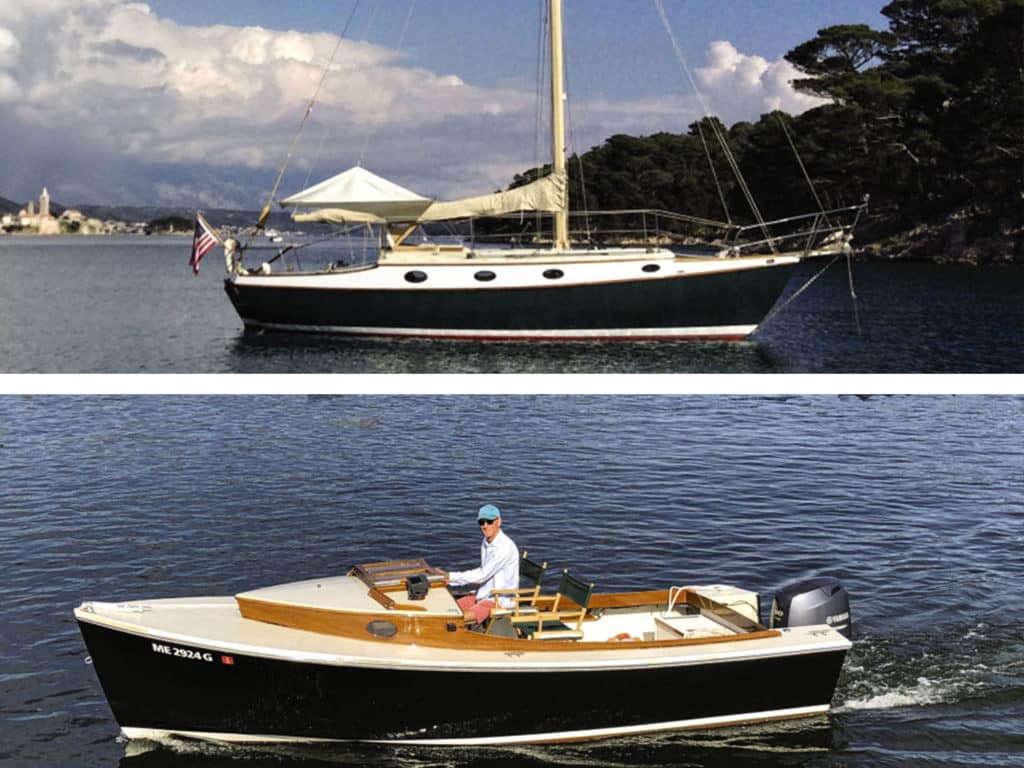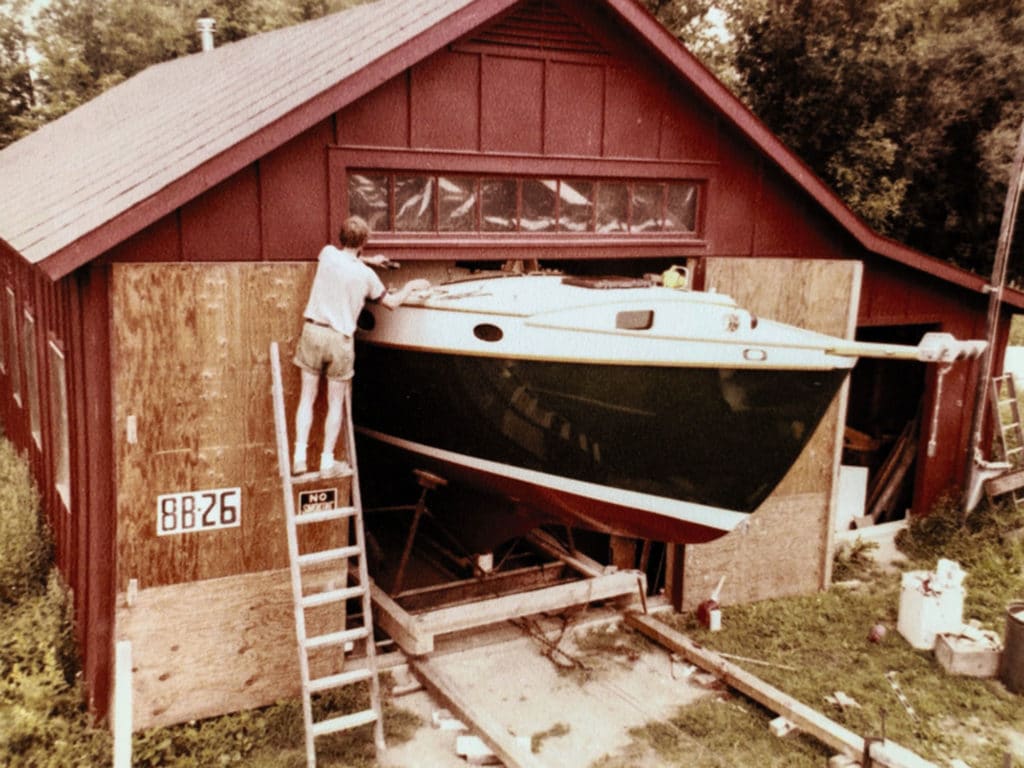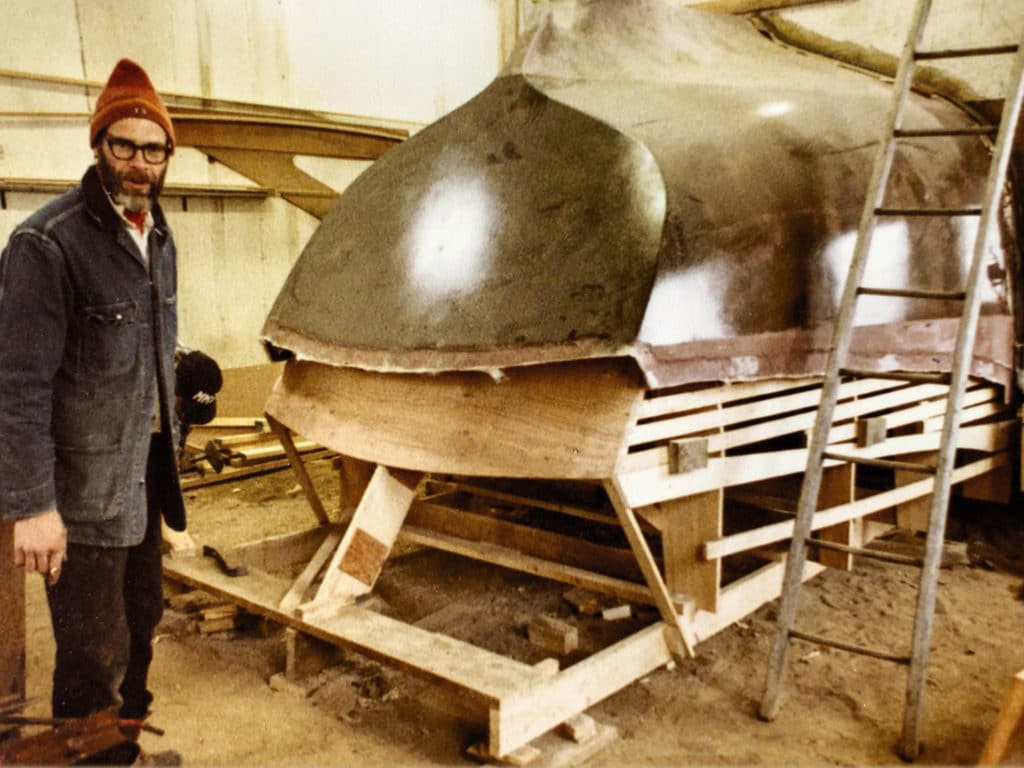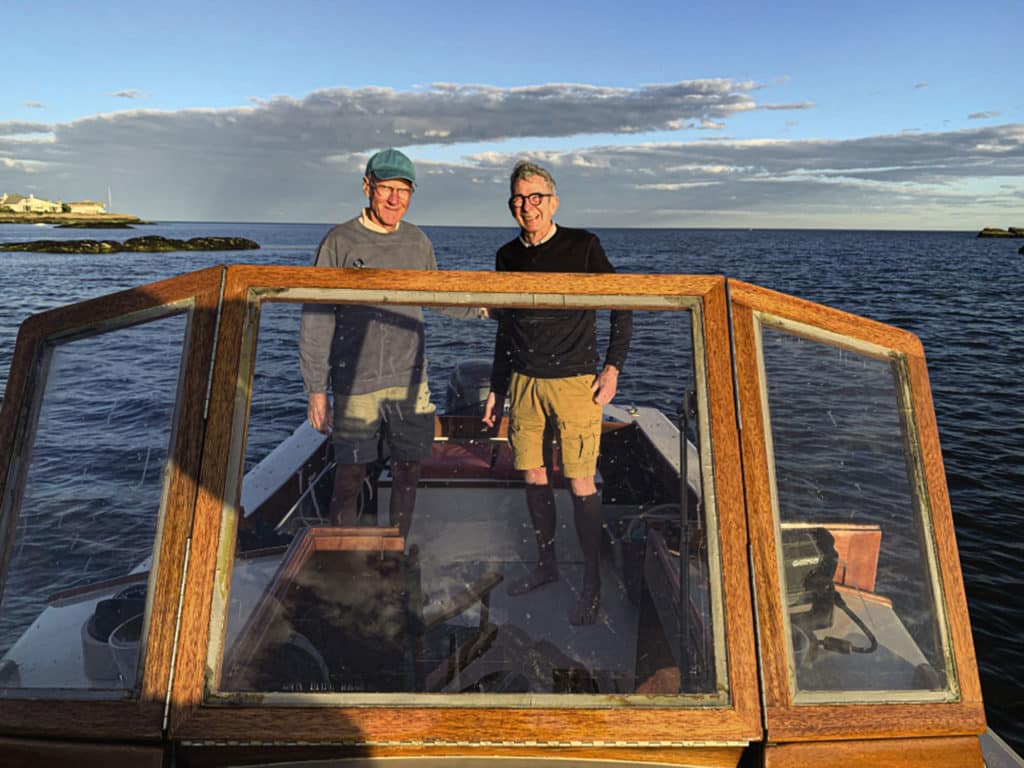
Forty years ago, David M. Stainton presented us with that indefinable but unmistakable thing: a good boat. Clarity, our 33-foot cutter, has since shown us thousands of miles of the world’s waters, from Maine to Trinidad, from Connecticut to Scotland to Turkey, adventures that were chronicled in more than 20 years of articles in this magazine.
David had drawn up the plans as a design exercise years before I signed the construction contract. His brief to himself: a comfortable, fast and traditional-looking vessel fit to go anywhere in any weather. On my first glance at the drawings, I fell in love. He created her over the span of two years in a building behind the brick farmhouse in Williston, Vermont, where he lived with his wife, Barbara, and daughter, Lilo. Construction was supposed to take one year, so when we moved into the second, Barbara served as shuttle diplomat between unhurried David and increasingly impatient me.
I should have calmed down.
During that second year, I met Brian Forsyth, who is with me still. Meanwhile, David was making something that would cement the mutual love of sailing that we discovered upon first meeting, which would be a sustaining thread of our lives together. She was launched in August 1980. Lilo bobbled the champagne bottle, Brian instantly dived into the harbor to retrieve it, and she nailed it on the second bash.
From our first year aboard, spent cruising to and through the Caribbean—Clarity was our first home together—we learned how sturdy, comfy and able she was, starting with her seeing us through a three-day storm at sea on our first offshore passage. We felt trust building inside us. We learned how to run her together smoothly, to kedge her off Chesapeake mud, to row out a second anchor, to take a wee-hour reef. She had an uncanny, purposeful rightness in her every inch and mile covered. In 1988, we sailed across the Atlantic to Scotland. Once again, we were slammed by a three-day storm, this one some 375 nautical miles off Ireland, with 90-mile-an-hour winds and 30-foot waves. As always, she shrugged it off. I was less blasé. Ever since then, we have kept her in Europe, taking a summer cruise each year and storing her on the hard wherever we end up, with no plans of sailing her back. We were younger then.
Halfway through our 17 years in the south of France and nearby waters, the annual return to favorite anchorages stopped generating new articles for Cruising World, but we have continued to savor the sensual life afloat, and have even gradually given ground on our original purist ways, allowing cushy things aboard such as an electric anchor windlass, roller furling, a fridge and GPS. We still use foot pumps for the sinks and still row the dinghy.
Something else happened during those later years in France, something that landed Clarity with a quirky amenity. Ever since we arrived in Europe, we’d been leaving the ship’s US document with the authorities each winter, retrieving it the following summer. We had become aware that the newly coalescing European Union had set a limit of 18 months on non-EU-flagged vessels sailing in EU waters, but even so, year after year, picking up the document went off without a hitch.
We began to dare to hope that we had arrived early enough in the EU process to excuse us from that limitation.
But one February day back in Connecticut, we received a letter from French Customs, forwarded by our French boatyard, saying that we must remove the vessel from the EU immediately. I called the boatyard manager, who was furious that they would make such a demand in the middle of the winter. She called the local customs office and gave them a good piece of her mind, and they relented, saying we could deal with the situation the following summer.

Six months later, I arrived in France with a sheaf of every contract, drawing and artifact of red tape I could find relevant to Clarity’s history. During a stressful week, I fired up my bureaucratic French and managed to import Clarity into the EU, paying the VAT (value-added tax) on her value, and receiving at the end a passeport du navire etranger. This foreign-vessel passport allows Clarity to remain in the EU indefinitely while keeping her US flag, and it transfers with ownership of the boat. I wrote about this process for the benefit of stateside readers, but to this day, we hardly ever see US-flagged boats in the Med.
In 2008, we sailed the thousand miles from France to Croatia, and we have been reveling in that sailor’s paradise ever since. Clarity spends the winters in a boatyard in Monfalcone, Italy, near Trieste, from which Croatian waters are just a few hours’ sail away.
Meanwhile, back in Connecticut, in the years after the 1988 trans-Atlantic voyage, we moved to a salt-water-front home with an empty dock and a nearby archipelago of pink granite islands called the Thimbles, ripe for sunset outings. We hunted around and found, in Belfast, Maine, a lovely 1958 21-foot picnic boat. Urchin not only filled the bill, but she also quickly became a beloved neighborhood accessory. If I were behind on the spring task list, working on her in the driveway, strollers would stop and scold me: “When’s she going in? It’s not summer till she’s at your dock.” Burbling down the harbor, she just seemed to make people smile.
Two years ago, that task list had gotten a bit ahead of us. Decay was riddling the mahogany cabin structure faster than I could drill holes and inject epoxy. The pre-launch work stretched on: more epoxy and coats of varnish, freshly painted topsides and boot top. For the first time, we went to Croatia for our summer cruise aboard Clarity with Urchin still on the trailer in the driveway. When we got back, it seemed urgent to get her launched. But there was just one last task: How might we address that saggy bit of the cockpit sole?

We were feeling around underneath when we chanced to poke the engine-bed timbers, and the finger went into the wood a couple of knuckles—peat moss. We looked at each other. It was time. I felt strangely relieved. She had not been made with a 60-year life span in mind; the half-round trim on the cabin was attached with copper boat nails. Still, it had been bothering me more and more to see her losing ground under our care. We didn’t have the skills to truly bring her back, and paying to have her restored would be way beyond our means. We needed to find people with the ability and enthusiasm to give her a next chapter.
A house just down the harbor from us had recently changed hands after lingering on the market for years. The features it offered—a marine railway leading to a huge boat shed—needed just the right buyer, and had finally found one. I walked down the street and knocked—a cold call. A woman answered, her expression suggesting she feared that I might be promoting an unwelcome cause. I introduced myself and told her we proposed a gift of Urchin, no strings attached.
“I can’t believe this is happening!” she said. “There are only three boats on this harbor that we love, and Urchin is one of them.” Jan told her husband, Joe, when he got home, and the next day they came over, climbed inside and out, over and under, and Joe said, “We gotta do this!” Turns out, Joe fabricates custom marine metalwork and is an amateur boatbuilder. The day after that, they came and hauled her away. That went well, but once again we had an empty dock.
When David finished building Clarity in 1980, his plans changed. He had thought of the boat, the first he had ever designed and built from scratch, as a prototype, to be followed by other semicustom examples. But the extra year of building had taken a toll on the family finances. Starting on another was not feasible. At the same time, he had been bitten by the boatbuilding bug. He and the family moved to Maine, where they bought Cranberry Island Boatyard, just off Northeast Harbor. There, David built a number of different boats, both sail and power, though the bulk of the business consisted of caring for the boats of the summer people, including some fine Herreshoff daysailers and other vessels of excellent pedigree.
After a few years, he felt he needed another revenue thread to keep the yard crew busy during the winters. He designed a 19-foot motorboat, dubbed the Western Way 19 after the channel between Cranberry Island and Mount Desert Island, and built a strip-planked, glassed-over prototype. It turned out to be a sweetie—a timeless spring in the sheer; a swift, soft, sure-footed ride in steep bay chop—that has become sort of a cult design, earning a waiting list of orders over the horizon for the rest of his life. The prototype, which no one had gotten around to naming, generated the mold for all the subsequent boats, and then became the yard launch and demo boat for potential WW19 buyers. After David died, Barb named it David M in his memory. Barb continued to run the yard for several more years, then sold it to a longtime employee who had his own workboat, at which point David M ended up unused in a boat shed at the yard for the last several years.
As we thought about what next boat to chase for our dock, the idea of a Western Way 19 naturally bobbed to the top of the list. David had taken me for a memorable spin years earlier on a visit to the island. We tried to find a used one online, but people just don’t let go of them. Commissioning a new one from the new yard owner was out of our reach. I asked Barb for leads, none of which panned out. Finally she said, “Well, it’s clear you guys need a boat for your dock.” A couple of days later, after checking with Lilo, Barb offered to lend us David M “for at least five years”…at no charge.
The Western Way 19 was offered in four models, all based on the prototype’s hull design: Bass Boat, Lobster Boat, Center Console, and Classic Launch. David M was the only Classic version ever built.

So, at the beginning of my serious cruising life, I acquired a one-off boat, designed and built by David M. Stainton, and now, 40 years later, we have another one-off from his pen, built by his hands, bookending our boating lives. Both boats share that rightness that feels so perfect under us and that harvests so many thumbs-up.
There’s a particular recurring experience that Clarity has given me over the years, a leitmotif in my daydreams of her. Here’s one way it can go:
There’s a famously bumpy run in Croatian waters called Kvarner Gulf, between the island of Unije and the mainland Istrian peninsula. In hopes of crossing it in a calm, I rise in the pre-dawn darkness and whisper a warning to Brian and friend Neil, my core crew: “Starting the engine.” I sneak down the anchorage, perhaps to a wave from a fellow early riser, and start along the austere, Bora-sculpted shore of Unije. As we round the last point into the open water, with 20 miles to go to the tip of Istria, the sun has still not peeked over Losinj, the mountainous island to the east. We slide along with some swell that keeps me alert, scanning for the dark water of wind. Finally, the first sunbeam warms my back and begins to dry the dew off the deck. Three hours out, when the crew would normally be taking the first morning dive overboard, we’re already 15 miles safely on our way. Clarity and I have given a small gift to Brian and Neil, and whoever else is just coming to, down below—more than 70 friends have sailed with us in Europe. Orange juice appears, along with the smell of coffee. Another day.
David M has done me that same favor, has brought me into a fine new day, late in my boating life.
We have begun to reckon with the looming need to let go of our beloved Clarity, so staunch and proud after all these years and miles. We are still just scratching the surface of all the coves and islands of the Croatian coast, but we are in our 70s and, as much as we continue to cherish every minute aboard, we recognize that we must put safety first so we can look back with only fond, unclouded memories of our times with her. We hope we can find a sailor who sparks to the qualities of beauty, ability and integrity that David M. Stainton imbued her with, a sailor who dreams of endless cruising in Europe. She’s ready for 40 more years. Meanwhile, David M bobs at our dock, ready for the next sunsetter.
After his studies at Juilliard, William Storandt spent several years in New York as a freelance percussionist before spending over a decade in Vermont, capped off by Clarity’s launching in Lake Champlain in 1980. After a year’s cruise together to the islands, Storandt and Brian Forsyth moved to Connecticut, where Storandt taught writing at Yale for 25 years before recently retiring. His 2001 book Outbound: Finding a Man, Sailing an Ocean, recounts their 1988 voyage to Scotland. Inquiries about the sale of Clarity may be directed to Storandt via email.








